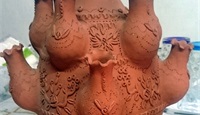
Applicant:
Action and Development Group of Kornos and Kornos Community Council
Communities Concerned - Bearers of the element:
Potters, Action and Development Group of Kornos and Kornos Community Council
Cooperative Society of Kornos Potters Ltd, traditional pottery merchants of the village and surrounding areas
Domain of Intangible Cultural Heritage:
Traditional craftsmanship
Date of inscription:
2016
Brief description:
The creation of red clay pottery in Kornos is done entirely by hand, with the main instrument being the low, slow-turning, foot-powered wheel. Pottery from Kornos has a simple design, which is limited to a few decorative strips that adorn the pots, a little below the neck, which are carved using a comb. Three techniques were applied for the decoration:
Stikti (punctate): a piece of comb is used to press down on the pot’s surface, as it is being spun on the wheel. This achieves linear designs. Furthermore, a splinter of wood or matchstick is used to create small superficial cavities / holes.
Anaglyfi (embossed): the potter creates by hand various types of birds, which it places in the belly of the pot. She designs embossed decorations on the lip of the pot or around it.
Trochoti (circular): it is a small cylindrical wheel made from wood, which is mounted on a poll in a way that allows it to spin. They would carve various shapes on it (i.e. squares) and then spin it around the pot. This decorating method is no longer used today.
Today, once the decorating is over, the pots are baked in modern ovens operating on gas or electricity. In the old days, the pots were baked in furnaces for ten to twelve hours. As opposed to the furnaces in Agios Demetrios and Kaminaria, which are cylindrical and open on top, the Kornos furnaces look more like those found in the rest of the island. They have a domed shape and on their facade they have a high-rise door. During baking, the Kornos furnace’s door would be sealed shut with pieces of broken pottery.
The pottery that is produced in Kornos varies in size and shape, depending on its use: pitharia (jugs used to create the soup trachanas; they were also used to store wine and water), pitharouthkia (pots to cook meat), kouzes (medium-shaped pots with necks, used to serve water), cooking utensils that were big and open. Besides the traditional pottery, which has survived the passage of time and is still being made, pottery created today has more decorative and aesthetic value, rather than practical. Even though the growth is slow, because the mastorisses tend to use the methods they were taught by previous generations, pottery is definitely evolving. Today, new types of pots are created, adjusted to modern day demands, such as fruit bowls, vases, mini jugs etc.